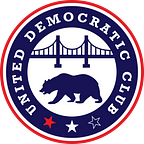Race Talks: Housing and the Racial Wealth Gap
Decades after the formal end of redlining, and an infamous re-development project razed a Black neighborhood, housing inequality is alive and well in San Francisco.
A panel of local leaders, whose work spans housing development, community investment and financial planning, joined the United Democratic Club discuss ways to break down existing barriers to housing and improve access to home ownership for communities that have been historically shut out of both.
“You can’t rent change; you have to own it,” said Neighborbuilt co-founder Daniel Edwards, at the second installment of Race Talks, a United Democratic Club event series focused on racial justice. Read about our first event on policing and criminal justice.
Housing is about much more than just a place to live. Racial barriers to home ownership — rooted in redlining, exclusionary zoning and an overall lack of housing production — have disenfranchised Black communities and aggravated the racial wealth gap over generations.
San Francisco has its own long history of segregation, enforced through discriminatory, New Deal-era mortgage regulations, “restrictive covenants” barring Black Americans from buying homes in desirable areas, single-family zoning capping housing supply, and everyday racism among residents. Starting in the 1940s, San Francisco’s so-called “Urban Renewal” redevelopment initiative devastated the Fillmore District, leaving Black residents with scant housing alternatives; during the same period, the City also expanded single-family zoning in white neighborhoods on the West Side.
“If you look at the disproportionate amount of public housing that is currently in Districts 10 and 11, we had redevelopment and it’s now OCII [San Francisco’s Office of Community Development and Infrastructure],” added Dion-Jay Brookter, executive director at Young Community Developers. ”So we’ve seen what didn’t necessarily work. And as we move forward and start thinking about mixed housing, it’s a question of: How do we make it proportionate across the city?”
According to the panelists, the solution to housing inequality lies in a mix of legislative changes to encourage mixed housing; removing barriers to development; downpayment assistance and other mortgage support; and even government incentives for affluent neighborhoods to integrate.
“I do believe that we should focus on government programs and subsidies that incentivize more affluent zip codes to diversify their racial makeup, because studies have shown that the zip code one grows up in has drastic impacts on life outcomes,” added Nadia Sesay, executive director of San Francisco’s OCII. “So not only do we need to invest resources back into Black communities, we need wealthy, predominantly white neighborhoods to truly integrate and share the wealth policies, encouraging meaningful community input in all aspects of housing development.”
Designated below market rate (BMR) housing also comes with limitations, explained Sean Peake, a certified financial planner at Morgan Stanley specializing in multigenerational wealth.
In San Francisco, BMR units generally continue with that designation into perpetuity — which means that if resold, the City mediates the sale and owners don’t capture the equity gains typical of Bay Area homes, and lose out on the mortgage deductions and other tax benefits that come with home ownership. That leaves families locked out of a primary factor in building generational financial stability.
“We still have to confront issues around access to those particular pieces of property, and we still need to confront the issues around access to high quality jobs and reasonable pay,” added Peake. “But absent those traditional property rights, it is very difficult for a family to continue to build wealth over the long term. That’s what white families have done in this country.”
Home ownership isn’t for everybody — any more than a college degree or any other individual asset is essential for success. What’s essential is to level the playing field and to open up the opportunities that housing affords.
“In personal empowerment, getting the knowledge, prioritizing your dollars, forcing the hand of the politicians, and partnering with the right folks, the benefits can be substantial,” added Peake.
Thanks to our panelists for participating: Nadia Sesay, Executive Director of San Francisco’s Office of Community Investment and Infrastructure; Daniel Edwards, Co-Founder of Neighborbuilt; Dion-Jay Brookter, Executive Director of Young Community Developers; Sean Peake, Certified Financial Planner, and moderator, Laura Foote, Executive Director of YIMBY Action with an intro by Noelle Bonner, CEO of Bonner Communications and UDC VP of Events.
The full recording of the event is available here on the United Democratic Club YouTube channel.
